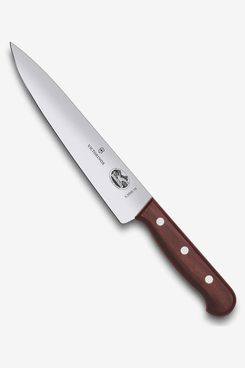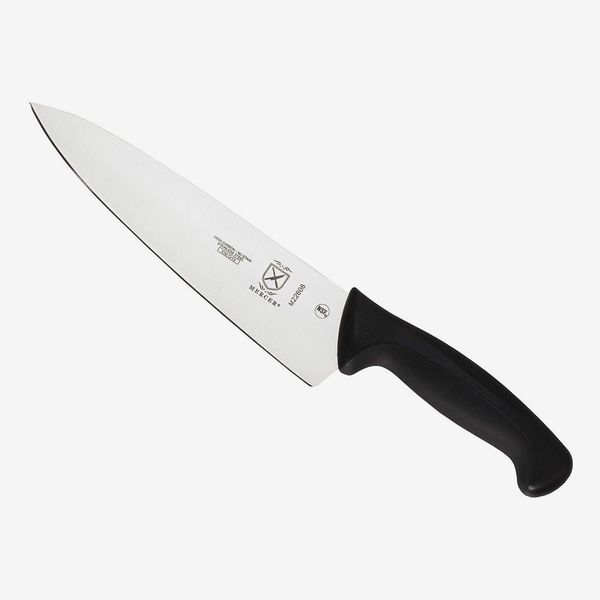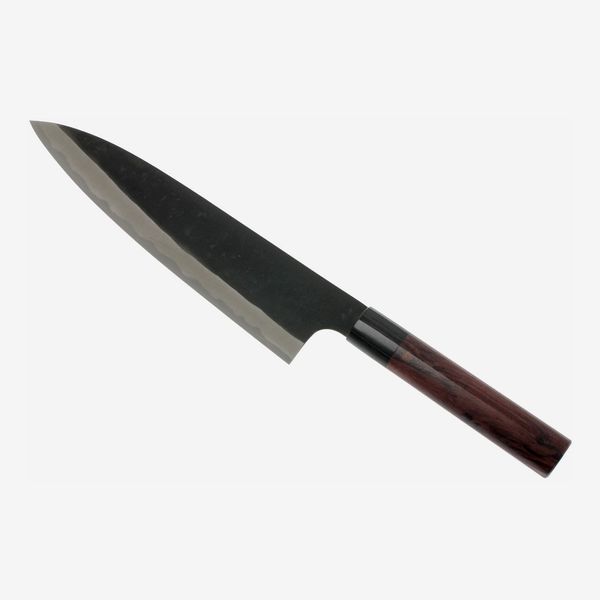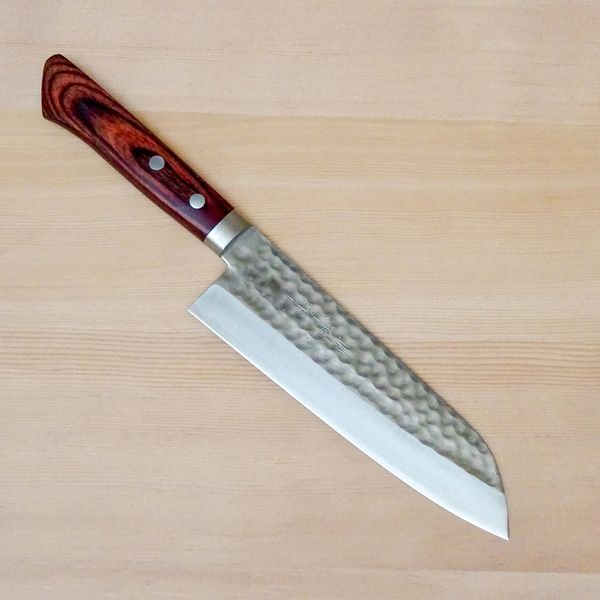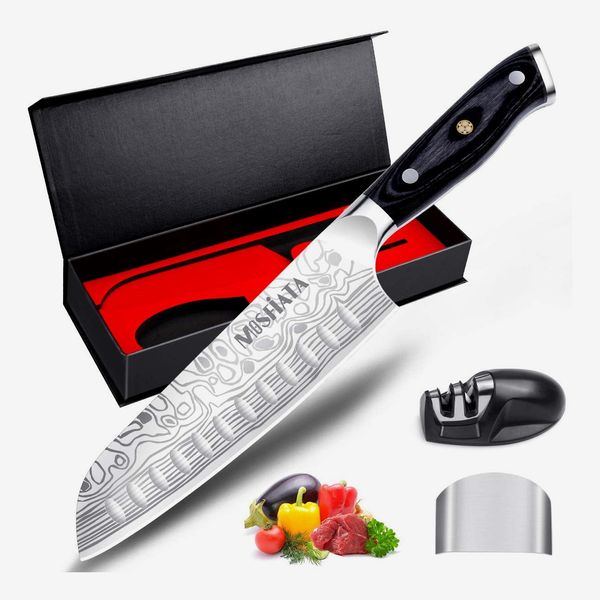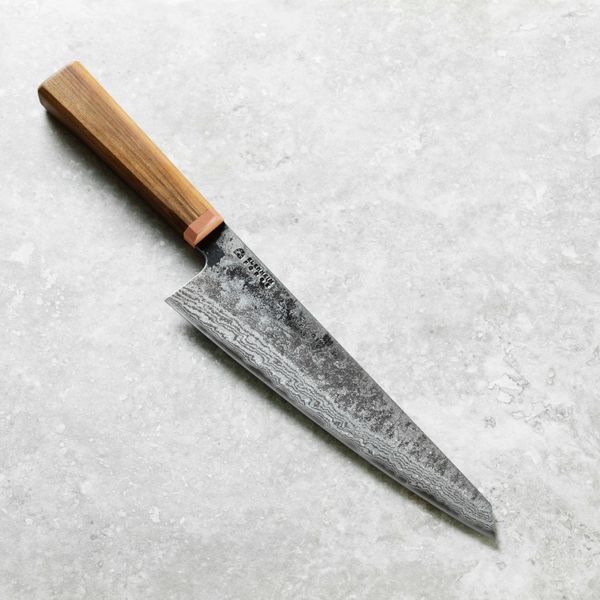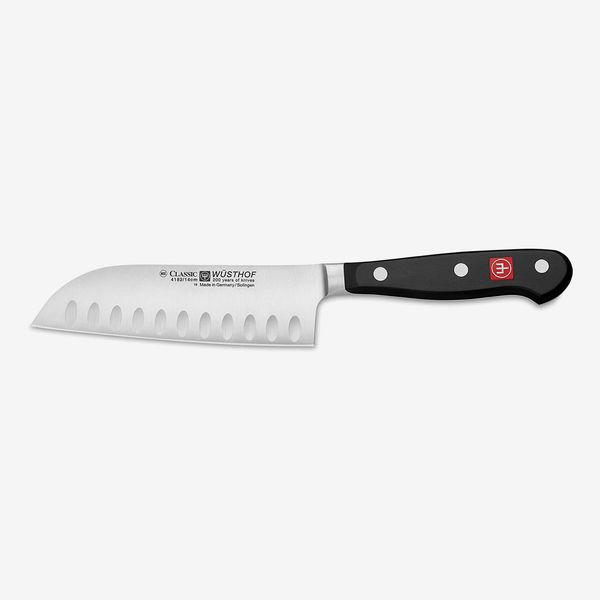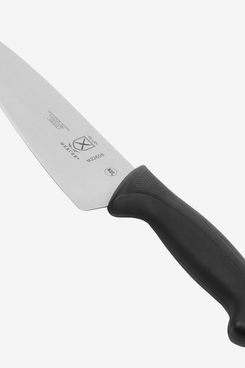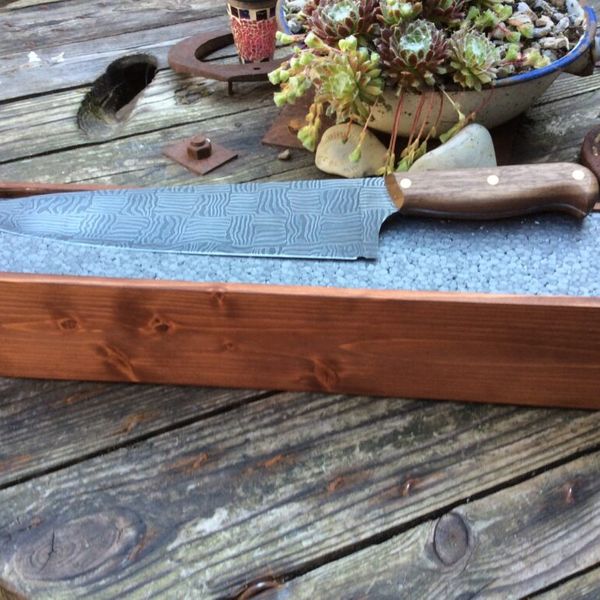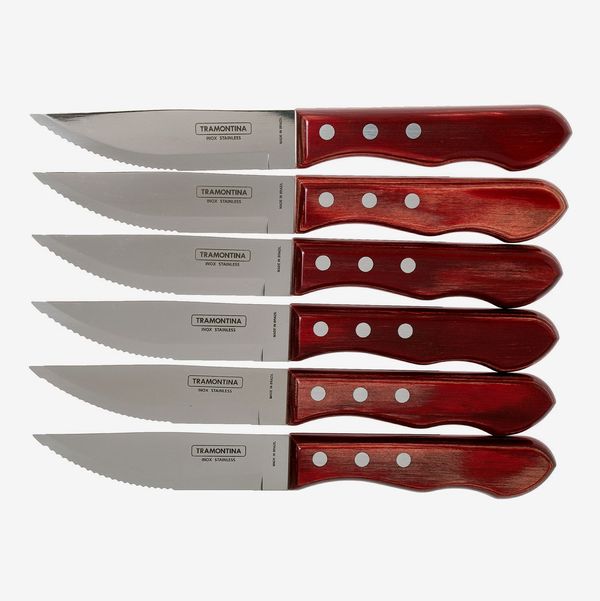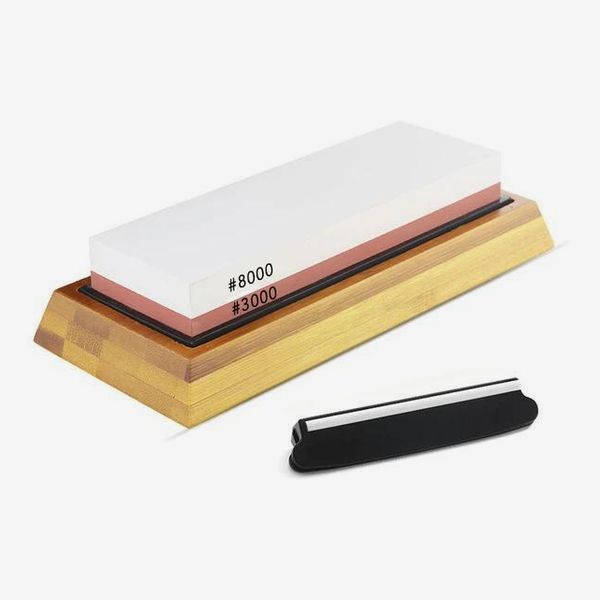
A chef’s knife is the go-to tool in your kitchen arsenal. It doesn’t matter if you’re filleting a sea bass on a Tuesday night or throwing together a stir-fry with whatever’s left in the fridge — for even a basic level of cutting, a top-quality knife will make all the difference. Buying one can seem daunting, though. We spoke to chefs and food experts to find out which blades they both use and recommend. We also browsed user reviews across Amazon, John Lewis, and Selfridges and (perhaps my favourite bit) hung out in knife sub-Reddits that analyse everything from the weightiness of handles to blade lengths.
Best overall | Best less-expensive | Best for left-handers | Best santoku | Best (less expensive) santoku | Best gyuto | Best dishwasher-safe | Best small | Best large | Best to gift
What we’re looking for:
Blade length: Chef’s knives come in a variety of lengths, though seven and eight inches are most common. A chef’s knife is designed for the broadest amount of tasks, but bigger or smaller models will help with more specific jobs — an eight-inch blade might be best suited for chopping a butternut squash or pumpkin, and a six-inch blade suited to large handfuls of herbs. We’ll list each blade’s length, but remember the size will often be a matter of personal preference; seven-inch blades fit my hands perfectly, so that’s what I tend to go for.
Weight: European-style knives tend to be heavier and Japanese-style knives lighter, but that’s not always the case. Knowing a knife’s exact weight, accounting for the handle’s material, can help you figure out which you’ll find the most comfortable.
Best overall chef’s knife
New! You can now save this product for later.
7.4 inches | 100g
In 2020, fourth-generation butcher Cara Nicoletti wrote a piece for our U.S. sister site about her favourite knives. As founder of sausage company Seemore Meats & Veggie, she’d found that these Victorinox knives “tend to last the longest and keep a sharp edge, even when being used daily on heavy projects.” While she favours a ten-inch stainless-steel blade, you can get them in a seven-inch, too. A similar seven-inch chef’s knife from Victorinox also came recommended by Pastaio founder Stevie Parle and Ioannis Grammenos, executive chef at Heliot Steak House, but is currently out of stock.
I bought my own Victorinox knife after reading about the brand on the r/chefsknives sub-Reddit, which has just over 150,000 members. Members mentioned the brand’s perfect balance of affordability versus quality (they’re also available in several places, such as Amazon, Selfridges, and John Lewis, though the latter sell their blades in-store only). They make great starter knives for beginner chefs as well as thoughtful gifts for keen cooks.
Best (less expensive) chef’s knife
New! You can now save this product for later.
8 inches | 190g
We previously called Mercer’s chef’s knife the best option on Amazon, thanks to the overwhelming number of positive reviews out of 50,000. One reviewer, a former chef, wrote that Mercer may be lesser known in the UK but is popular in the U.S., allegedly used in several cookery schools. Fans include a knife aficionado who said it could slice and chop a variety of vegetables and meat to the same standard as his Victorinox knives. At half the price of the Victorinox, it’s as good an option for the kitchen as for a camping trip or a small gift for a student moving into halls in the autumn.
Best chef’s knife for left-handers
New! You can now save this product for later.
9 inches | 185g
Typically, the sharpened edge of a knife is on the left side, catering (perhaps unsurprisingly) to right-handed customers. If you’re left-handed, swapping hands alone won’t do enough when, let’s say, you’re filleting fish or deboning a chicken, holding the knife at a steep angle. That leaves you with a couple of options: Opt for a double-edged or ambidextrous blade, such as a santoku or gyuto knife, with both sides sharpened. Or look for a tool specifically designed for left-handers, like this handsome Japanese forged blade from the Eden Kanso Aogami series. It’s longer than a typical chef’s knife at nine inches but isn’t too heavy, especially compared to some of the other Japanese blades we have featured.
Best santoku knife
New! You can now save this product for later.
6 inches | 135g
Although Japanese santoku knives are distinct from chef’s knives, we’re including them here for both their distinct shape — a straight-edged blade, soaring into a curved top — and smaller size. Keshia Sakarah, chef-owner of Brixton’s Caribe and Baruru supper club founder, recommended this knife from Masutani. “The handle is made from pakka wood, which makes it durable through excessive use, while the blade is high-carbon, stainless-steel clad, and ground thin, making its cutting performance superior,” she says. She particularly loves how the hammered blade’s grooves “allow the food being cut to slide off the blade easily” and uses her Santoku as a general chopping knife for “almost everything,” from dicing onions to chopping up meat for curry goat. The name, after all. roughly refers to “three uses”: slicing dicing, and mincing. Sakarah buys hers in person at Pop Brixton’s Kataba Knife and Sharpening Services, but it’s also available online.
Best (less expensive) santoku knife
New! You can now save this product for later.
7 inch blade | 620g
This cheaper santoku knife by Mosfiata comes highly recommended on Amazon, with 2,700 reviews, 81 percent of which are five stars. Reviewers were impressed by the quality of the stainless steel, the weightiness of the blade, and the ease of use. It’s a much heavier blade compared to a chef’s knife, which could take some getting used to (one reviewer likened it to handling a sword). But even amateur cooks said they could cut everything from red meat to root vegetables with ease. This knife also comes with a finger guard, making it safer to use, and a sheath for storing it in a drawer (experts told us this helps protect the tip of the blade from contact damage).
Best gyuto knife
New! You can now save this product for later.
8.6 inches | Custom weight
Peckham-based Blenheim Forge knives have come recommended to us by several chefs, including Parle and Jackson Boxer, owner of Notting Hill’s Orasay and Vauxhall’s Brunswick House. I’ve also tested their santoku knife and gyuto knife before (sadly, they were on loan, and I had to return them), and they were some of the most beautiful knives I’ve ever used. Full disclosure: This is not as essential a kitchen knife, used more for fiddlier tasks like deboning a joint of meat or julienning vegetables. If you do want a gyuto knife’s flat, thin blade in your kitchen, I suggest investing in a good one — hence us featuring an option this expensive.
Boxer told us Blenheim Forge’s knives are made to order, meaning you can customise one to suit your preferences. “It weighs nothing in my hand,” he noted, though if you want, you can also order one online. “It’s my all-purpose kitchen knife for the majority of my tasks. It’s rarely out of my hand.” The blade is made from Blue Paper steel — the composition of knives can get a little technical, but in short, this Japanese steel is manufactured with the addition of tungsten and chromium, increasing sharpness and resistance to wear.
Best dishwasher-safe chef’s knife
New! You can now save this product for later.
7.8 inches | 150g
I wouldn’t dream of putting my more expensive knives in the dishwasher, as it can damage them, but for cheaper knives, I make an exception. That said, if you want to rest easier at night it’s worth considering a water-resistant chef’s knife. Steak chef Grammenos (and, it turns out, Gordon Ramsay) swears by German manufacturer Wüsthof, whose chef’s knife Grammenos last told us he found “nice and cheap” while able to “go very easily through your dishwasher.” If popping it in the dishwasher, lie it down on the lowest level, away from other cutlery. “Water won’t damage it, as the blades are made to be resistant,” he said.
Best small chef’s knife
New! You can now save this product for later.
5 inches | 121g
Wüsthof also makes a Japanese-style santoku knife that comes recommended by Amanda Cohen, chef of New York City’s Dirt Candy. “I’m a serial monogamist when it comes to knives, and right now, I’m in a long-term relationship with this one,” Cohen told our U.S. sister site. “A shorter knife gives you more control, so I’m through with six-inch knives for the moment.” She says it’s light enough to use for hours and versatile, “switching between really precise knife work and hacking away at tougher vegetables.” It’s forged from stainless steel, but the handle is polypropylene, a sort of plastic composite.
Best large chef’s knife
New! You can now save this product for later.
10 inches | 230g
Nicoletti told us larger chef’s knives can handle the duties typically reserved for cleavers, such as cutting through a chicken carcass for spatchcocking. This 10-inch version of the Mercer knife we featured above has all the same features, including an ergonomic handle ideal for applying more force. This blade can also be used for chopping cumbersome vegetables, such as pumpkins, cauliflower, or butternut squash.
Best chef’s knife to gift
New! You can now save this product for later.
9 inches | 198g
I’ll just say that more expensive doesn’t always mean better with chef’s knives. You’ll most enjoy the knife that works for your hands and typical tasks. If you’re looking to splash out, though, both Parle and chef Tom Griffiths are fans of Derbyshire-based Blok. Its chef’s knives are currently sold out. But Falcon Forge, an in-demand forge in Yorkshire run by a former British Rail engineer, makes this blade from tough, flexible Damascus steel — literal swords were forged from it. The blade here is full tang, meaning the metal runs the full length of the handle (cheaper blades finish where the handle begins). Each knife comes in a bespoke wooden box, handmade by Falcon Forge.
Other knives and tools we've written about:
New! You can now save this product for later.
New! You can now save this product for later.
Our experts:
Jackson Boxer, owner of Orasay and Brunswick House
Amanda Cohen, chef of New York City’s Dirt Candy
Ioannis Grammenos, executive chef at Heliot Steak House
Tom Griffiths, chef, hospitality consultant, and founder of Flank
Cara Nicoletti, founder of Seemore Meats & Veggies
Stevie Parle, founder of Pastaio
Keshia Sakarah, chef-owner of Caribe
The Strategist UK is designed to surface the most useful, expert recommendations for things to buy across the vast e-commerce landscape. Read about who we are and what we do here. Our editors update links when possible, but note that deals can expire and all prices are subject to change.
